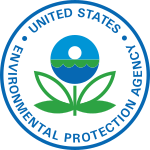United States Environmental Protection Agency
 Seal | |
Logo | |
 Flag | |
| Agency overview | |
|---|---|
| Formed | December 2, 1970 |
| Jurisdiction | Federal Government of the United States |
| Headquarters | William Jefferson Clinton Federal Building 38°53′38″N 77°01′44″W / 38.8939°N 77.0289°W |
| Employees | 14,581 |
| Agency executives |
|
| Website | https://epa.gov/ |
The Environmental Protection Agency (EPA) is an agency of the United States government. It works to protect human health and the environment. The EPA does this job by writing rules and making sure that they are followed.[1] The idea for the EPA was first thought of by President Richard Nixon. The EPA was started on December 2, 1970, after Nixon signed a presidential order. The order starting the EPA was approved through discussions in the Senate and the House. The agency is led by an administrator, who is appointed by the President, and accepted by the Senate. The EPA is not a cabinet department, but the administrator is usually cabinet rank.
The EPA is headquartered in Washington D.C.. It has regional offices for 10 different regions. It has 27 laboratories. The agency does environmental testing, research, and education. The role of the EPA is to enforce and maintain national standards with different kinds of laws. The agency also works with industries and all levels of government in many kinds of ways to stop polluting Earth. They also try to save energy.
EPA offices
[change | change source]- Office of the Administrator (OA)[2]
- Office of Administration and Resources Management (OARM)[3]
- Office of Air and Radiation (OAR)[4]
- Office of Chemical Safety and Pollution Prevention (OCSPP)[5]
- Office of the Chief Financial Officer (OCFO)[6]
- Office of Enforcement and Compliance Assurance (OECA)[7]
- Office of Environmental Information (OEI)[8]
- Office of General Counsel (OGC)[9]
- Office of Inspector General (OIG)[10]
- Office of International and Tribal Affairs (OITA)[11]
- Office of Research and Development (ORD)[12]
- Office of Solid Waste and Emergency Response (OSWER)[13]
- Office of Water (OW)[14]
EPA regions
[change | change source]
Each EPA regional office is responsible within its states for putting into use the Agency's programs, except those programs that have been chosen only for that state.
- Region 1: responsible within the states of Connecticut, Maine, Massachusetts, New Hampshire, Rhode Island, and Vermont.
- Region 2: responsible within the states of New Jersey and New York. It is also responsible for the US territories of Puerto Rico, and the U.S. Virgin Islands.
- Region 3: responsible within the states of Delaware, Maryland, Pennsylvania, Virginia, West Virginia, and the District of Columbia.
- Region 4: responsible within the states of Alabama, Florida, Georgia, Kentucky, Mississippi, North Carolina, South Carolina, and Tennessee.
- Region 5: responsible within the states of Illinois, Indiana, Michigan, Minnesota, Ohio, and Wisconsin.
- Region 6: responsible within the states of Arkansas, Louisiana, New Mexico, Oklahoma, and Texas.
- Region 7: responsible within the states of Iowa, Kansas, Missouri, and Nebraska.
- Region 8: responsible within the states of Colorado, Montana, North Dakota, South Dakota, Utah, and Wyoming.
- Region 9: responsible within the states of Arizona, California, Hawai'i, Nevada, and the territories of Guam and American Samoa.
- Region 10: responsible within the states of Alaska, Idaho, Oregon, and Washington.
Each regional office also puts into use of programs on Native American land, except those programs for Tribal authorities.
References
[change | change source]- ↑ [1], Our mission and what we do.
- ↑ "About the Office of the Administrator | About EPA | US EPA". Epa.gov. 2010-11-17. Retrieved 2012-10-21.
- ↑ "About the Office of Administration and Resources Management (OARM) | About EPA | US EPA". Epa.gov. 2010-11-17. Retrieved 2012-10-21.
- ↑ "About the Office of Air and Radiation (OAR) | About EPA | US EPA". Epa.gov. 2010-11-17. Retrieved 2012-10-21.
- ↑ "About the Office of Chemical Safety and Pollution Prevention (OCSPP) | About EPA | US EPA". Epa.gov. 2010-11-17. Retrieved 2012-10-21.
- ↑ About the Office of the Chief Financial Officer (OCFO)
- ↑ "About the Office of Enforcement and Compliance Assurance (OECA) | About EPA | US EPA". Epa.gov. 2010-11-17. Retrieved 2012-10-21.
- ↑ "About the Office of Environmental Information (OEI) | About EPA | US EPA". Epa.gov. 2010-11-17. Retrieved 2012-10-21.
- ↑ "About the Office of General Counsel (OGC) | About EPA | US EPA". Epa.gov. 2010-11-17. Retrieved 2012-10-21.
- ↑ About OIG
- ↑ "About the Office of International and Tribal Affairs (OITA) | About EPA | US EPA". Epa.gov. 2010-11-17. Retrieved 2012-10-21.
- ↑ "About the Office of Research and Development (ORD) | About EPA | US EPA". Epa.gov. 2010-11-17. Retrieved 2012-10-21.
- ↑ "About the Office of Solid Waste and Emergency Response (OSWER) | About EPA | US EPA". Epa.gov. 2010-11-17. Retrieved 2012-10-21.
- ↑ "About the Office of Water | About EPA | US EPA". Epa.gov. 2010-11-17. Retrieved 2012-10-21.
